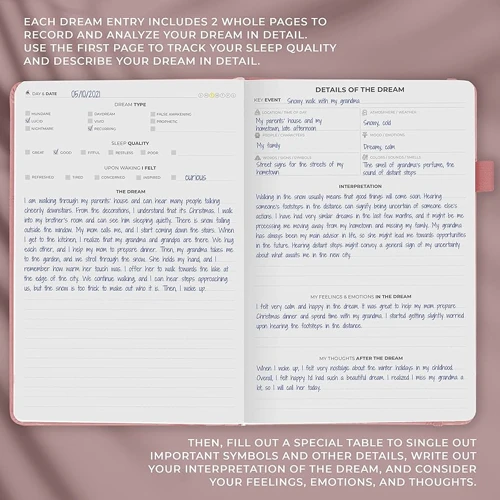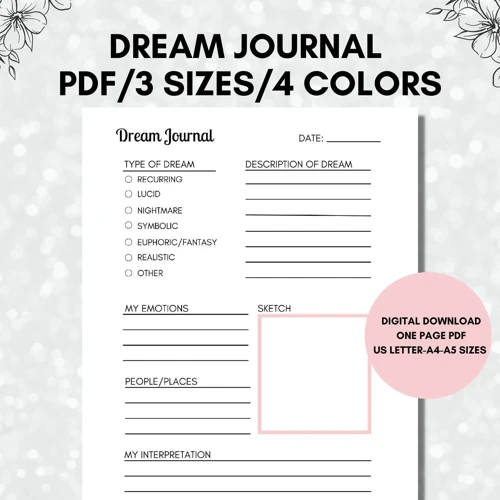The Power of Dream Journals in Enhancing Writing Skills
Have you ever experienced a dream so vivid and complex that it felt like a movie playing in your mind? Dreams have long held a mysterious fascination for humans, with their ability to transport us to fantastical worlds and unimaginable scenarios. But did you know that keeping a dream journal can actually enhance your writing skills? By capturing the details of your dreams, exploring the symbolism within them, and stimulating your creativity, dream journals can serve as a powerful tool for writers. In this article, we will delve into the significance of dreams, the benefits of keeping dream journals, various techniques for dream journaling, how dream journals improve writing skills, and the ways in which dreams can inspire different forms of writing such as fiction and poetry. Get ready to unlock the power of your dreams and take your writing to new heights.
The Significance of Dreams

The Significance of Dreams
– Dreams have long been a source of fascination and intrigue, captivating the human mind for centuries. They hold a special place in our lives, offering insights into our subconscious and providing a glimpse into our deepest desires, fears, and emotions. The significance of dreams lies in their ability to communicate with us in a language that is both symbolic and deeply personal. When we pay attention to our dreams, we open ourselves up to a world of hidden meaning and untapped potential.
– Dreams can serve as a wellspring of inspiration for writers, unlocking new ideas and storylines that may not have been accessible to us in our waking hours. The enigmatic nature of dreams allows us to explore themes and concepts that we may not have consciously considered before. By tapping into the subconscious, dreams provide a source of raw material that can be molded and shaped into compelling narratives.
– Dreams can offer valuable insights into our own lives and experiences. They have the power to reveal underlying emotions and unresolved conflicts, which can be invaluable for character development and plot progression in writing. By analyzing the symbols and events in our dreams, we can gain a deeper understanding of ourselves and the world around us.
– Dreams also have the potential to break through creative barriers and overcome writer’s block. When we are stuck in our writing, dreams can serve as a well of new ideas and perspectives. They offer a fresh lens through which we can view our work, providing innovative solutions to narrative dilemmas and sparking a renewed sense of creativity.
– The significance of dreams in enhancing writing skills lies in their ability to tap into the depths of our imagination and subconscious. They offer a unique perspective and a wealth of creative possibilities. By embracing the power of dreams and incorporating them into our writing practice, we can elevate our storytelling and create work that resonates deeply with readers.
The Benefits of Keeping Dream Journals

The benefits of keeping dream journals are numerous and can have a profound impact on enhancing writing skills. Here are three key advantages:
1. Capturing Vivid Details: Dream journals allow writers to document the intricate and vivid details of their dreams, which can serve as a rich resource for storytelling. By recording specific imagery, sensations, and emotions experienced in dreams, writers can tap into a wellspring of unique material for their writing projects.
2. Exploring Symbolism: Dreams are often filled with symbolic representations of subconscious thoughts and feelings. By keeping a dream journal, writers can analyze these symbols and delve deeper into their personal and universal meanings. Understanding symbolism can add depth and layers to narratives, allowing writers to create nuanced and thought-provoking stories with hidden messages.
3. Stimulating Creativity: Dream journals serve as a gateway to unlocking creativity. A single dream can ignite a multitude of ideas and inspire new narratives. By regularly engaging with dreams through journaling, writers can train their minds to think outside the box, embrace unconventional ideas, and push the boundaries of their imagination. Dream journals provide a constant source of inspiration that can fuel writing projects and infuse them with fresh and innovative perspectives.
1. Capturing Vivid Details
– One of the key benefits of keeping a dream journal is the ability to capture vivid details. Dreams are often fleeting, and upon waking, we tend to forget the specific images, sensations, and emotions we experienced. By recording our dreams in a journal, we can preserve these details and delve back into them later for inspiration. The act of writing down our dreams helps to solidify the memories and make them more accessible for future reference.
– In your dream journal, use descriptive language to vividly recount the sights, sounds, smells, tastes, and textures you encountered in your dream. Pay attention to the smallest details, even if they seem insignificant at first. These details can serve as building blocks for your writing, adding depth and authenticity to your descriptions. As you document your dreams, try to engage all of your senses and truly immerse yourself in the dream world you experienced.
– Capturing vivid details in your dream journal is not only beneficial for writing about your own dreams but can also be a valuable resource for crafting fictional worlds. By observing and recording the intricate details of your dreams, you can gather a wealth of inspiration and material for creating believable and immersive settings in your stories.
– Keeping a dream journal can also help you establish a connection between dreams, intuition, and writing. As you develop the habit of recording your dreams, you may begin to notice patterns, symbols, or recurring themes that emerge. These insights can spark new ideas or offer profound meaning that you can infuse into your writing. It’s a practice that can sharpen your intuition and deepen your understanding of your own creative process.
– It’s worth mentioning that certain dreams may contain common dream symbols that hold significance in the realm of writing. Symbols such as doors, keys, mirrors, or even water can carry metaphorical weight and serve as powerful storytelling devices. By recognizing these symbols in your dreams and exploring their meanings, you can incorporate them into your writing to add layers of depth and symbolism.
Capturing vivid details in a dream journal is not only a practice that honours the experiences of your dreams, but it also becomes a treasure trove of inspiration for your writing endeavors.
2. Exploring Symbolism
– One of the fascinating aspects of dreams is the presence of symbolism. Dreams often present us with a myriad of symbols, images, and metaphors that can hold deep meaning. By keeping a dream journal, we have the opportunity to explore and decode the symbolism within our dreams, which can greatly enhance our writing skills.
– Symbols in dreams can be personal, representing unique experiences and emotions specific to the dreamer. They can also be universal, representing archetypal themes and concepts that have a collective meaning across cultures and time. By analyzing and understanding the symbolism in our dreams, we can tap into a rich source of inspiration for our writing.
– Dream symbolism can serve as a bridge between the conscious and unconscious mind, revealing hidden desires, fears, and conflicts that often find their way into our storytelling. Symbols in dreams can manifest as objects, animals, people, or even landscapes, each carrying its own significance. For example, a dream about a snake might symbolize transformation or deception, while a dream about flying could represent a sense of freedom or escaping limitations.
– By exploring the symbolism in our dreams, we can uncover layers of meaning in our writing. We can infuse our stories with symbolism that adds depth and resonance to our characters, settings, and plotlines. Symbolism adds richness to the reader’s experience, inviting them to interpret and engage with the text on multiple levels.
– Keeping a dream journal allows us to track recurring symbols or themes that may appear throughout different dreams. This awareness can deepen our understanding of our own subconscious patterns and themes, allowing us to incorporate them consciously into our writing. Internalizing the symbolism from our dreams can lead to more meaningful and impactful storytelling.
– Exploring symbolism within our dreams through a dream journal is a powerful tool for writers. It offers a window into the hidden realms of our imagination and allows us to tap into the universal language of symbols. By incorporating symbolism into our writing, we can create stories that resonate deeply with readers, evoking emotions and sparking thought-provoking interpretations. So, delve into the world of symbolism within your dreams, and unlock the true power of your writing.
3. Stimulating Creativity
3. Stimulating Creativity
– One of the remarkable benefits of keeping a dream journal is its ability to stimulate creativity. When we delve into the depths of our dreams and explore the unique landscapes they present, we open ourselves up to a world of limitless imagination. Dreams can introduce fantastical scenarios, surreal imagery, and unconventional narratives that can serve as a wellspring of inspiration for our writing.
– Dream journaling encourages us to think outside the box and break free from self-imposed limitations. By documenting our dreams, we are able to capture fleeting moments of brilliance that might otherwise slip away. These fragments can be transformed into compelling storylines or poetic imagery, breathing life into our writing in ways we may not have imagined.
– Dreams often defy the boundaries of logic and reality, allowing us to explore unconventional ideas and unconventional thinking. Our dreams can offer unique perspectives and unconventional solutions that can help us overcome creative blocks and push our writing in unexpected directions. The fluidity and boundless creativity of dreams can infuse our writing with a sense of freedom and originality that captivates readers.
– Keeping a dream journal also enables us to uncover recurring themes, symbols, and motifs that may manifest throughout our dreams. These recurring elements can be woven into our writing, creating a sense of cohesion and depth. By integrating dream symbolism into our storytelling, we can add layers of meaning that resonate with readers on a subconscious level.
– Embracing the power of dreams can ignite our creative spark and foster a mindset of curiosity and exploration. Dreams have a way of unlocking our creativity and inspiring us to think beyond the confines of our everyday experiences. By incorporating dream elements into our writing, we can create works that are rich in imagination, pushing the boundaries of what is possible in storytelling.
– By cultivating a habit of dream journaling, we can tap into the vast well of creativity that lies within our subconscious minds. Dreams provide a gateway to a world of endless possibilities and unexpected connections. They prompt us to ask “what if” and challenge us to explore new ideas and unconventional approaches to our writing. Through dream journaling, we can unleash the full potential of our creative abilities and take our writing to new and extraordinary heights.
Techniques for Dream Journaling

Techniques for Dream Journaling
– Dream journaling is a powerful practice that allows us to record and explore the rich tapestry of our dreams. To make the most of this process, it’s important to employ certain techniques that enhance our ability to capture and analyze the content of our dreams. One technique is to keep a journal by your bedside, ensuring that it is easily accessible upon waking. This helps to capture the details of your dreams before they fade away into the depths of your memory. Additionally, writing immediately upon waking is crucial, as it allows you to capture the fresh and vivid memories of your dreams. Using descriptive language in your journal entries is another technique that can bring your dreams to life on the page. By vividly describing the people, places, and emotions experienced in your dreams, you can create a more comprehensive record that can be revisited and analyzed later. These techniques for dream journaling provide a foundation for extracting insights and inspiration from your dreams, further deepening your writing practice.
1. Keep it by Your Bedside
1. Keep it by Your Bedside
– One of the most important techniques for effective dream journaling is to keep your journal by your bedside. By having it within arm’s reach, you can easily jot down your dreams as soon as you wake up, before the details start to fade away. Keeping a journal by your bedside also serves as a visual reminder to prioritize your dreams and commit to the practice of recording them.
– Having your dream journal nearby allows you to capture those fleeting moments of inspiration and vivid imagery that often accompany the waking from a dream. It enables you to capture the essence of the dream before it becomes diluted by the distractions and demands of daily life. When your journal is within reach, it becomes a dedicated space for honoring your dream experiences and engaging with them on a deeper level.
– Another benefit of keeping your journal by your bedside is that it helps facilitate a seamless transition from the dream world to the waking world. As soon as you wake up, reach for your journal and begin writing without delay. This helps to maintain the freshness and authenticity of your dream memories. By recording your dreams immediately upon waking, you can capture the raw emotions, vivid details, and intricate symbolism that may slip away if not documented promptly.
– In addition to having your journal by your bedside, consider keeping a pen or pencil with it. This eliminates any obstacles or potential distractions that may arise from having to search for writing utensils in the morning. By streamlining the process, you increase the likelihood of consistently recording your dreams and maintaining a regular dream journaling practice.
– Keeping your dream journal by your bedside creates a habit and establishes a routine that reinforces the importance and value of your dreams. Making your dream journal a primary focus of your morning routine sets the intention to prioritize and explore the significance of your dreams. It creates a sacred space for self-reflection and fosters a stronger connection with your subconscious mind. By nurturing this connection, you can tap into a wealth of creative inspiration and personal insights that will enhance your writing skills. So, keep your dream journal by your bedside, and let your dreams guide you along your writing journey.
2. Write Immediately Upon Waking
– One of the most effective techniques for dream journaling is to write immediately upon waking. This is because our dreams are often fresh in our minds upon awakening, and the details are more likely to be vivid and accurate. As we gradually transition from the dream state to wakefulness, it’s important to capture the essence of the dream before it fades away.
– Keep a journal or notebook by your bedside, ready to be filled with your dream recollections as soon as you wake up. This way, you can quickly jot down the key elements, emotions, and events of the dream without letting them slip away.
– When writing about your dreams, be as detailed as possible. Describe the setting, characters, actions, and any other notable aspects of the dream. Use descriptive language to bring your dreams to life on the pages of your journal. This will not only help you better remember the dream, but it will also serve as a valuable resource for future writing endeavors.
– It’s important to note that dreams can be fleeting, and as time passes, we may start to forget the specifics of our dreams. By writing immediately upon waking, we increase the chances of capturing the essence of the dream in its most authentic form. This immediacy allows us to tap into the raw emotions and experiences that can fuel our writing.
– By developing the habit of writing immediately upon waking, we train our minds to prioritize and value our dreams. We become more attuned to the significance of dreams in our creative process, and we establish a stronger connection between our dreaming and writing selves.
– Writing immediately upon waking also helps in developing a sense of discipline in our writing practice. It sets the tone for the day and signals to our subconscious that our dreams are important and worthy of exploration.
– By incorporating this technique into your dream journaling routine, you can ensure that you capture the essence of your dreams and harness their power to enhance your writing skills. So, next time you wake up from an intriguing dream, grab your journal, and start writing before the details slip away.
3. Use Descriptive Language
3. Use Descriptive Language
– One of the techniques that can significantly enhance the effectiveness of your dream journal is to use descriptive language. When you wake up from a dream, take a moment to carefully observe and recall the details. Paying attention to sensory experiences, such as sights, sounds, smells, tastes, and textures, can help bring your dreams to life on the page. Use vivid and evocative words to describe the settings, characters, and events in your dreams.
– By using descriptive language, you not only create a vivid picture of your dreams, but you also hone your writing skills. Descriptive writing allows readers to immerse themselves in the story, making it more engaging and memorable. As you practice describing the details of your dreams, you’ll become more adept at creating rich and immersive sensory experiences in your writing.
– To effectively use descriptive language, it’s important to tap into your own emotions and reactions that accompany the dream. Take a moment to reflect on how the dream made you feel. Were you scared, joyful, anxious, or exhilarated? Incorporating the emotional aspect into your descriptions can add depth and resonance to your writing.
– Don’t be afraid to experiment with figurative language and literary devices to enhance your descriptions. Metaphors, similes, personification, and other rhetorical devices can help you paint a more vivid picture of your dreams. These techniques not only make your writing more engaging but also expand your writing skills by pushing you to think creatively and make unexpected connections.
– Using descriptive language in your dream journal also allows for better reflection and analysis. When you vividly capture the details of your dreams, you have a wealth of material to analyze and draw insights from. Descriptive language acts as a bridge between the dream world and waking consciousness, making it easier to identify recurring themes, symbols, and patterns in your dreams. This can lead to a deeper understanding of your subconscious mind, as well as provide inspiration for your writing projects.
– So, whether you’re describing the majestic landscape of a dream or the intricate details of a character’s appearance, using descriptive language in your dream journal not only enhances the quality of your entries but also strengthens your writing skills by cultivating your ability to evoke emotions and create vivid imagery. Don’t miss the opportunity to fully immerse yourself in the power of words.
How Dream Journals Improve Writing Skills

Dream journals have a profound impact on improving writing skills by enhancing observation skills, developing narrative abilities, and expanding vocabulary. When we regularly record our dreams in a journal, we train ourselves to become keener observers of the world around us. We become more adept at capturing vivid details, noticing subtleties, and paying attention to the nuances of human interactions and environments. This heightened sense of observation translates directly into our writing, allowing us to create more authentic and immersive scenes. Additionally, dream journals enable us to practice and develop our narrative abilities. The process of recounting dreams fosters storytelling skills, as we learn to structure our dreams into coherent narratives with a clear beginning, middle, and end. We also gain practice in incorporating descriptive language, engaging dialogue, and plot development. Dream journals serve as a rich source of inspiration for expanding our vocabulary. Dreams often present us with unfamiliar scenarios, unique settings, and a variety of characters. By reflecting on our dreams and describing them in detail, we naturally encounter new words and phrases that can be integrated into our writing, enhancing its richness and depth. So, whether you aspire to be a novelist, poet, or any kind of writer, embracing the power of dream journals can be a transformative step in honing your craft
1. Enhancing Observation Skills
1. Enhancing Observation Skills
– Keeping a dream journal can greatly enhance your observation skills as a writer. Dreams often present us with intricate and detailed scenarios that require keen observation to capture accurately. When you write down the vivid details of your dreams, you train yourself to pay attention to the nuances and intricacies of different elements. This skill translates directly to your writing, allowing you to create richly descriptive scenes and immersive worlds for your readers.
– In your dream journal, focus on capturing sensory details such as the colors, sounds, smells, and textures experienced in your dreams. By honing your ability to observe and describe these sensory elements in your dreams, you develop a heightened sense of awareness that carries over into your writing. Your descriptions become more vivid, allowing readers to fully immerse themselves in the world you’ve created.
– Additionally, dream journaling provides an opportunity to practice observing and interpreting symbols. Dreams often contain symbols that hold personal or universal meanings. By noting these symbols in your journal, you sharpen your ability to recognize and interpret symbolism in both your dreams and your writing. This skill can add depth and layers of meaning to your stories, making them more engaging and thought-provoking for readers.
– By regularly practicing observation skills through dream journaling, you train your mind to be more attentive to the world around you. This attentiveness extends beyond the realm of dreams and can have a profound impact on your everyday life. You become more attuned to the subtleties of human behavior, the beauty of nature, and the small details that often go unnoticed. As a writer, this heightened observation allows you to bring authenticity and realism to your characters and settings.
– The process of keeping a dream journal and recording the details of your dreams cultivates your ability to observe and describe the world in a more nuanced and vivid way. Through this practice, you become a writer with a keen eye for detail, capable of creating immersive and captivating stories that leave a lasting impression on your readers.
2. Developing Narrative Abilities
2. Developing Narrative Abilities
– Dreams are cinematic experiences that often unfold like stories, complete with characters, settings, and plotlines. By keeping a dream journal and documenting the narratives that unfold in our dreams, we can improve our narrative abilities as writers. As we delve into the details of our dreams, we become more attuned to the elements that make a compelling story, such as character development, conflict, and resolution.
– Dream journaling allows us to practice the art of storytelling in a unique and imaginative way. We can analyze the structure of our dreams and identify narrative arcs, seeing how they unfold and develop over time. This analysis helps us understand the importance of pacing, tension, and plot progression in our own writing.
– Dreams often present us with unexpected twists and turns, challenging us to think creatively and adapt to new situations. As we recount and interpret these dream narratives within our journal, we strengthen our ability to come up with inventive plot twists, vibrant characters, and engaging storylines. Our dreams serve as a wellspring of inspiration that can spark new ideas and approaches to storytelling.
– Additionally, examining the narrative elements of our dreams can help us refine our writing style. We can analyze the language used in our dreams, the descriptions of the settings and characters, and the overall tone of the dream narrative. This analysis allows us to experiment with different writing techniques and find our unique voice as writers.
– Developing narrative abilities through dream journaling also expands our understanding of storytelling beyond traditional literary conventions. Often, dreams defy logic and follow a more surreal or symbolic narrative structure. By embracing this unconventional form of storytelling, we can push the boundaries of our own writing and create narratives that are rich in depth and meaning.
By actively engaging with the narratives that unfold within our dreams, we can develop our narrative abilities, hone our storytelling skills, and create compelling and captivating work that resonates with readers.
3. Expanding Vocabulary
- 3. Expanding Vocabulary: Dream journals can also be a valuable tool for expanding one’s vocabulary. Dreams are often filled with vivid imagery, strange landscapes, and unique scenarios. As we record these dreams in our journals, we can encounter words and phrases that we may not have encountered in our everyday lives. These unfamiliar words can provide us with opportunities to learn and explore new language. By actively seeking to understand and incorporate these words into our writing, we can enrich our vocabulary and add depth to our storytelling.
Reflection and Analysis of Dreams

Reflection and Analysis of Dreams
Delving into the realm of dreams goes beyond simply jotting down the details of what occurred during our slumber. Reflection and analysis of dreams play a crucial role in understanding the deeper meaning and messages that our subconscious mind is trying to convey. By taking the time to ponder and explore our dreams, we can gain valuable insights into our thoughts, emotions, and experiences. Reflection involves revisiting the dream journal entries, examining recurring themes, and identifying patterns that may be significant in our waking lives or writing endeavors. Analysis involves unraveling the symbolism embedded in the dream, deciphering the hidden messages, and uncovering subconscious insights. This process of self-reflection and analysis not only helps us better understand ourselves but also enhances our writing skills by allowing us to infuse our work with deeper meaning and layers of complexity. So, pick up your dream journal and embark on a journey of self-discovery and creative growth.
1. Identifying Themes and Patterns
– Dreams are filled with rich symbolism and recurring themes that can be analyzed to uncover deeper meanings. By keeping a dream journal, writers can identify common motifs and patterns that emerge across multiple dreams. This process allows writers to gain insight into their subconscious and discover themes that may be recurring in their own lives.
– When examining dream journals, writers may start noticing recurring symbols or scenarios that appear in their dreams. These symbols can hold personal significance and may represent aspects of the writer’s life, desires, or fears. By identifying these themes, writers have a unique opportunity to explore them further in their writing. They can create compelling characters and narratives that revolve around these symbolic elements.
– Dreams may also reveal patterns in the emotions and experiences that are portrayed. By analyzing these patterns, writers can delve into the underlying themes that their dreams are trying to convey. For example, a recurring theme of loss or betrayal in dreams may indicate unresolved emotions or fears that can be explored in writing.
– Identifying themes and patterns in dreams can also help writers develop a stronger sense of coherence and consistency in their storytelling. By recognizing the recurring motifs in their dreams, writers can consciously incorporate these elements into their narratives, creating a sense of depth and continuity that resonates with readers.
– It’s important to note that dream interpretation is subjective, and the meaning of symbols can vary from person to person. While there are some common dream symbols that have been widely studied, each individual brings their unique experiences and associations to their dreams. Writers can use resources like /common-dream-symbols-in-writing/ as a starting point for understanding symbolism, but ultimately, it’s up to the writer to interpret their own dreams in a way that is meaningful to them and enhances their writing.
– By identifying themes and patterns in their dreams, writers can tap into the rich symbolism and recurring elements that emerge from their subconscious. This process can add depth, coherence, and personal meaning to their writing, elevating their storytelling and immersing readers in a world that is unique and captivating.
2. Unearthing Subconscious Insights
2. Unearthing Subconscious Insights
– Dreams have a unique way of bypassing the conscious mind and delving into the depths of our subconscious. They can provide a window into our deepest thoughts, desires, and fears that may not be readily accessible to us when we are awake. By keeping a dream journal, we have the opportunity to unearth these subconscious insights and use them to inform our writing.
– Many renowned authors have credited their dreams as a source of inspiration for their literary works. For example, Mary Shelley’s famous novel “Frankenstein” was inspired by a dream she had, and Robert Louis Stevenson’s “Strange Case of Dr. Jekyll and Mr. Hyde” was also conceived from a dream. These examples highlight the profound impact that dreams can have on creative endeavors.
– When we write down our dreams in a journal, we create a record of our subconscious experiences. By reflecting on these dreams, we can begin to piece together patterns, symbols, and recurring themes that offer a deeper understanding of ourselves and our writing. This self-reflection allows us to tap into our intuition and draw out meaningful insights that can enrich our storytelling.
– Dreams often present us with scenarios and emotions that we may not be consciously aware of. They can serve as a means of processing unresolved conflicts, exploring our deepest desires, and confronting fears that we may subconsciously bury in our waking life. By analyzing these dream elements, we can bring these hidden aspects of ourselves to light and incorporate them into our writing to create more authentic and compelling narratives.
– By unearthing subconscious insights through dream journaling, we can also develop a heightened sense of emotional authenticity in our writing. Dreams have a way of accessing our raw emotions and presenting them in their truest form. By incorporating these authentic emotions into our storytelling, we can create characters and narratives that resonate deeply with readers.
– By keeping a dream journal and unearthing subconscious insights, we can tap into a wellspring of inspiration and gain a deeper understanding of ourselves as writers. Dreams offer a direct line to our innermost thoughts and emotions, providing a rich source of material that can enhance the depth and authenticity of our writing. So, as we explore our dreams and reflect on their subconscious insights, we open ourselves up to a world of creative possibilities and unlock the true power of our writing.
3. Inspiring Story Ideas
– Dreams are a treasure trove of inspiration for writers, offering a rich source of unique and intriguing story ideas. When we dive into the realm of dreams through the practice of dream journaling, we uncover a wealth of narrative possibilities that can breathe life into our writing.
– Each dream is like a doorway to a different world, filled with vivid characters, surreal settings, and gripping plots. By recording our dreams in a journal, we capture these elements and can revisit them later for inspiration. The bizarre nature of dreams can spark our imagination, pushing us to think outside the box and challenge traditional storytelling conventions.
– Dreams often present us with intriguing dilemmas, conflicts, and mysteries that can be adapted into captivating storylines. They can introduce complex character dynamics, unexpected twists, and thought-provoking themes. The symbolism and imagery within dreams can be used as powerful storytelling devices, adding depth and layers to our narratives.
– Additionally, dreams grant us access to our subconscious desires and fears, unveiling untapped themes and motifs that can shape our stories. Exploring the emotions and experiences within our dreams allows us to create authentic and relatable characters, as well as delve into universal themes that resonate with readers.
– Dream-inspired story ideas can range from fantastical adventures in otherworldly realms to intimate explorations of the human psyche. They can serve as the foundation for various genres, such as science fiction, fantasy, mystery, and psychological thrillers. The surreal and unpredictable nature of dreams lends itself to innovative storytelling that captures the reader’s attention and leaves a lasting impact.
– By embracing the inspiring story ideas found within our dreams, we can infuse our writing with a sense of wonder, mystery, and endless possibilities. Exploring the depths of our dreaming minds allows us to unleash our creativity and craft narratives that transport readers to extraordinary and unforgettable worlds.
Writing Prompts from Dreams

Writing Prompts from Dreams
Dreams have a remarkable capacity to ignite our imagination and provide us with unique writing prompts. They can be a treasure trove of ideas, characters, and plotlines that can breathe life into our writing. Here are some ways in which dreams can serve as powerful writing prompts:
1. Unconventional Storylines: Dreams often present us with strange and fantastical scenarios that can inspire unconventional storylines. From navigating surreal landscapes to encountering mythical creatures, dreams can provide the perfect foundation for unique and imaginative narratives. Consider the strange situations and settings from your dreams and let them guide you to create a captivating story.
2. Compelling Characters: Dreams introduce us to a myriad of characters, some familiar and others entirely new. These characters can provide rich material for developing complex and engaging characters in your writing. Pay attention to the personalities, motivations, and relationships within your dreams, and bring them to life on the page. You might find that even the most enigmatic dream characters have the potential to captivate your readers.
3. Emotional Resonance: Dreams have a way of evoking powerful emotions that can be translated into your writing. Whether it’s the fear of being chased or the elation of flying, dreams can stir up intense feelings that can be used to create emotional depth in your stories. Use the emotions you experience in your dreams as inspiration to explore the emotional landscapes of your characters and bring authenticity to their journeys.
4. Surreal Symbols: Dreams are often filled with symbolic imagery that can spark creative ideas. Pay attention to the recurring symbols or motifs that appear in your dreams. These symbols can serve as metaphors or themes in your writing, adding depth and layers of meaning to your stories. Whether it’s a mysterious key, a broken mirror, or a haunting melody, let the symbols from your dreams guide your storytelling.
5. Twists and Turns: Dreams are known for their unpredictability, often taking unexpected twists and turns. Embrace the element of surprise from your dreams and incorporate it into your writing. Use unexpected plot twists and turns to keep your readers hooked and engaged. Let your dreams challenge your storytelling conventions and take your writing in exciting new directions.
Writing prompts from dreams can be the key to unlocking your creativity and infusing your work with a sense of wonder and originality. By tapping into the depths of your dreams, you can discover a wealth of ideas and inspiration that will breathe life into your writing. So, next time you wake up from a vivid dream, grab your dream journal and let the imaginative possibilities unfold.
Using Dream Elements in Fiction

Using Dream Elements in Fiction
– Dreams can serve as a rich source of inspiration for writers looking to infuse their fiction with a touch of the fantastical. By incorporating dream elements into their storytelling, authors can add depth, symbolism, and a sense of otherworldliness to their narratives.
– One way to use dream elements in fiction is by integrating dream sequences into the plot. These sequences can provide insight into a character’s psyche, reveal hidden emotions, or foreshadow future events. By capturing the ethereal quality of dreams and blending them seamlessly into the narrative, writers can create a sense of mystery and intrigue for their readers.
– Another way to utilize dream elements is by incorporating dream symbolism into the story. Dreams often contain potent symbols that carry deep emotional meaning. By weaving these symbols into the fabric of the narrative, writers can add layers of complexity and resonance to their work. For example, a recurring dream symbol such as a butterfly could be used to represent transformation or freedom, enhancing the thematic significance of the story.
– Writers can also draw inspiration from the surreal and imaginative nature of dreams to create unique settings and events in their fiction. Dreamscapes can serve as the backdrop for extraordinary adventures or act as a threshold between reality and unreality. By harnessing the strange and unpredictable aspects of dreams, authors can transport readers to extraordinary worlds that exist only in the realm of the imagination.
– It’s important to note that while the incorporation of dream elements in fiction can be incredibly powerful, it should be done with careful consideration. The use of dreams should serve a purpose within the narrative, enhancing the story and deepening the reader’s understanding of the characters and themes.
– Using dream elements in fiction allows writers to tap into the limitless boundaries of their imagination. By infusing their narratives with the symbolism, mystery, and fantastical qualities of dreams, authors can create stories that captivate readers and leave a lasting impression.
Dream-Induced Inspiration for Poetry
Dream-Induced Inspiration for Poetry
– Dreams have long been a fertile ground for poets, offering a wealth of inspiration and imagery that can ignite the creative spark. The ethereal and often surreal nature of dreams lends itself perfectly to the world of poetry, allowing poets to capture the essence of their dreams and transform them into evocative verses.
– Dreams provide poets with a rich tapestry of emotions and sensations to explore. The vivid and sometimes disjointed imagery of dreams can be translated into vivid metaphors, similes, and descriptive language in poetry. The dream world offers a unique lens through which poets can convey complex emotions and experiences, often in ways that are not possible through more traditional forms of expression.
– Dream-induced inspiration for poetry often stems from the emotional impact of dreams. Dreams can evoke intense feelings of joy, sorrow, fear, or longing, which can be channeled into powerful and emotive poetry. By delving into the emotional landscape of their dreams, poets can tap into a deep well of raw emotions that resonate with readers.
– Dreams also offer a playground for experimentation in poetic form and structure. The dream world is inherently fluid and unpredictable, and poets can mirror this in their writing. They can play with line breaks, rhythm, and imagery to create dreamlike atmospheres in their poems. Dream-induced poetry can push the boundaries of traditional poetic conventions, inviting readers into a realm of wonder and imagination.
– Poets can also use dreams as a means of self-reflection and introspection. Dreams often delve into the subconscious, revealing hidden desires, fears, and memories. By exploring the themes and symbols within their dreams, poets can gain insight into their own psyche and the human condition. This introspective journey can be translated into introspective poetry that resonates with readers on a deeply personal level.
Dreams provide poets with a vast landscape of inspiration, from vivid imagery to intense emotions. Dream-induced poetry invites readers on a journey into the realms of the subconscious, challenging conventional poetic norms and offering a unique and captivating reading experience. By harnessing the power of dreams, poets can unlock new depths of creativity and create works that leave a lasting impact.
Conclusion
Conclusion
– Dream journals have proven to be a powerful tool in enhancing writing skills. By keeping a record of our dreams, we are able to capture vivid details, explore symbolism, and stimulate our creativity. Techniques such as keeping the journal by our bedside, writing immediately upon waking, and using descriptive language help us to make the most of our dream journaling practice.
– The act of journaling our dreams not only improves our observation skills but also develops our narrative abilities. By analyzing the themes and patterns in our dreams, we can discover subconscious insights that can fuel our writing. Dream journals also serve as a source of inspiration for story ideas and writing prompts.
– Dream elements, such as characters, settings, and events, can be integrated into our fictional writing, adding depth and intrigue to our stories. Furthermore, dreams can inspire poetry, as the ethereal and symbolic nature of dreams lends itself well to the medium of poetry.
– In conclusion, dream journals offer a pathway to harnessing the power of our dreams and utilizing them to enhance our writing skills. By delving into the significance of dreams, utilizing dream journaling techniques, and exploring the ways in which dreams can improve our writing, we open ourselves up to a world of creativity and inspiration. So, grab a pen, keep a dream journal by your bedside, and embark on a journey into the realm of dreams. You never know what extraordinary stories may unfold.
Frequently Asked Questions
FAQs about Dream Journals and Writing Skills
1. How can dream journals help improve writing skills?
Dream journals can enhance writing skills by capturing vivid details, exploring symbolism, stimulating creativity, and providing material for storytelling.
2. Can keeping a dream journal help overcome writer’s block?
Yes, dreams can offer new ideas and perspectives that can break through creative barriers and inspire fresh writing.
3. What techniques can I use for dream journaling?
Some techniques include keeping the journal by your bedside, writing immediately upon waking, and using descriptive language to capture the essence of your dreams.
4. Can analyzing my dreams help with character development in writing?
Absolutely! Dreams can provide insights into emotions, conflicts, and experiences that can deepen and enrich your characters.
5. How can dreams expand my vocabulary as a writer?
Dreams often introduce unfamiliar words and concepts, allowing writers to explore new vocabulary and expand their linguistic repertoire.
6. Can dreams be used as writing prompts?
Yes, the vivid imagery and intriguing storylines in dreams can serve as excellent writing prompts, providing a rich source of inspiration.
7. Are there common dream symbols that writers can incorporate into their work?
Yes, common dream symbols can add depth and meaning to your writing. They can be a powerful tool for conveying themes and subtext.
8. Can dreams inspire poetry?
Absolutely! The abstract and symbolic nature of dreams lends itself well to the creation of evocative and thought-provoking poetry.
9. Can reflecting on and analyzing dreams help with personal growth as a writer?
Definitely! Dream analysis can reveal patterns, themes, and subconscious insights that can aid in personal growth and self-awareness as a writer.
10. How can writers use dream elements to enhance their fiction?
By incorporating dream elements into their fiction, writers can create a sense of wonder, mystery, and unpredictability, enriching the storytelling experience for readers.








